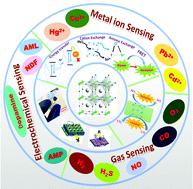当前位置:
X-MOL 学术
›
Inorg. Chem. Front.
›
论文详情
Our official English website, www.x-mol.net, welcomes your feedback! (Note: you will need to create a separate account there.)
Perovskite nanomaterials as optical and electrochemical sensors
Inorganic Chemistry Frontiers ( IF 7 ) Pub Date : 2020-06-03 , DOI: 10.1039/d0qi00306a Jesna George K 1, 2, 3, 4 , Vishaka V Halali 1, 2, 3, 4 , Sanjayan C. G. 1, 2, 3, 4 , V. Suvina 1, 2, 3, 4 , M. Sakar 1, 2, 3, 4 , R. Geetha Balakrishna 1, 2, 3, 4
Inorganic Chemistry Frontiers ( IF 7 ) Pub Date : 2020-06-03 , DOI: 10.1039/d0qi00306a Jesna George K 1, 2, 3, 4 , Vishaka V Halali 1, 2, 3, 4 , Sanjayan C. G. 1, 2, 3, 4 , V. Suvina 1, 2, 3, 4 , M. Sakar 1, 2, 3, 4 , R. Geetha Balakrishna 1, 2, 3, 4
Affiliation

|
The perovskite family is comprised of a great number of members because of the possible flexible substitution of numerous ions in its system. These compounds have a broad range of applications due to their outstanding optoelectronic properties in solar cells, photodetectors, lasers, and light-emitting diodes (LEDs). Perovskite nanocrystals (PNCs) are highly tolerant to defects, unlike metal chalcogenides, and do not require surface passivation to retain high quantum yields. Interestingly, the defect structures and trap states in perovskites are often found only in their conduction and/or valence bands and not in the mid-states of the bandgap. Such characteristics essentially boost their properties and largely favor their sensing applications. Perovskites have thus been attempted by numerous groups to address the serious concern of heavy metal ions, biomolecules, and gas molecule detection with high selectivity and sensitivity limits. In this context, the current review describes recent developments and various strategies used in applying perovskites as probes for sensing various contaminants, drugs, and gases in the environment. The focus is on two main aspects: (i) the exploitation of the high fluorescence of these perovskites for optical sensing and (ii) the utilization of the redox ability of these perovskites for electrochemical sensing. This review also outlines the existing challenges, giving future perspectives for developing perovskite-based sensing probes of high sensitivity and enduring stability for a range of environmental analytes.
中文翻译:

钙钛矿纳米材料作为光学和电化学传感器
钙钛矿家族由许多成员组成,因为它的系统中可能会灵活地替换众多离子。这些化合物由于在太阳能电池,光电探测器,激光器和发光二极管(LED)中具有出色的光电性能,因此具有广泛的应用范围。与金属硫属元素化物不同,钙钛矿纳米晶体(PNC)对缺陷的耐受性很高,并且不需要表面钝化即可保留高量子产率。有趣的是,钙钛矿中的缺陷结构和陷阱态通常仅在其导带和/或价带中发现,而在带隙的中间态中却没有。这样的特性实质上提高了它们的性能,并在很大程度上有利于其传感应用。因此,许多团体都尝试使用钙钛矿解决重金属离子的严重问题,生物分子和具有高选择性和灵敏度极限的气体分子检测。在这种情况下,本综述描述了将钙钛矿用作探测环境中各种污染物,药物和气体的探针的最新进展和各种策略。重点是两个主要方面:(i)利用这些钙钛矿的高荧光进行光学传感,以及(ii)利用这些钙钛矿的氧化还原能力进行电化学传感。这篇综述还概述了现有的挑战,为开发对各种环境分析物具有高灵敏度和持久稳定性的基于钙钛矿的传感探头提供了未来的展望。本篇综述描述了将钙钛矿用作探测环境中各种污染物,药物和气体的探针的最新进展和各种策略。重点是两个主要方面:(i)利用这些钙钛矿的高荧光进行光学传感,以及(ii)利用这些钙钛矿的氧化还原能力进行电化学传感。这篇综述还概述了现有的挑战,为开发对各种环境分析物具有高灵敏度和持久稳定性的基于钙钛矿的传感探头提供了未来的展望。当前的综述描述了将钙钛矿用作探测环境中各种污染物,药物和气体的探针的最新进展和各种策略。重点是两个主要方面:(i)利用这些钙钛矿的高荧光进行光学传感,以及(ii)利用这些钙钛矿的氧化还原能力进行电化学传感。这篇综述还概述了现有的挑战,为开发对各种环境分析物具有高灵敏度和持久稳定性的基于钙钛矿的传感探头提供了未来的展望。(i)利用这些钙钛矿的高荧光进行光学传感,以及(ii)利用这些钙钛矿的氧化还原能力进行电化学传感。这篇综述还概述了现有的挑战,为开发对各种环境分析物具有高灵敏度和持久稳定性的基于钙钛矿的传感探头提供了未来的展望。(i)利用这些钙钛矿的高荧光进行光学传感,以及(ii)利用这些钙钛矿的氧化还原能力进行电化学传感。这篇综述还概述了现有的挑战,为开发对各种环境分析物具有高灵敏度和持久稳定性的基于钙钛矿的传感探头提供了未来的展望。
更新日期:2020-07-14
中文翻译:

钙钛矿纳米材料作为光学和电化学传感器
钙钛矿家族由许多成员组成,因为它的系统中可能会灵活地替换众多离子。这些化合物由于在太阳能电池,光电探测器,激光器和发光二极管(LED)中具有出色的光电性能,因此具有广泛的应用范围。与金属硫属元素化物不同,钙钛矿纳米晶体(PNC)对缺陷的耐受性很高,并且不需要表面钝化即可保留高量子产率。有趣的是,钙钛矿中的缺陷结构和陷阱态通常仅在其导带和/或价带中发现,而在带隙的中间态中却没有。这样的特性实质上提高了它们的性能,并在很大程度上有利于其传感应用。因此,许多团体都尝试使用钙钛矿解决重金属离子的严重问题,生物分子和具有高选择性和灵敏度极限的气体分子检测。在这种情况下,本综述描述了将钙钛矿用作探测环境中各种污染物,药物和气体的探针的最新进展和各种策略。重点是两个主要方面:(i)利用这些钙钛矿的高荧光进行光学传感,以及(ii)利用这些钙钛矿的氧化还原能力进行电化学传感。这篇综述还概述了现有的挑战,为开发对各种环境分析物具有高灵敏度和持久稳定性的基于钙钛矿的传感探头提供了未来的展望。本篇综述描述了将钙钛矿用作探测环境中各种污染物,药物和气体的探针的最新进展和各种策略。重点是两个主要方面:(i)利用这些钙钛矿的高荧光进行光学传感,以及(ii)利用这些钙钛矿的氧化还原能力进行电化学传感。这篇综述还概述了现有的挑战,为开发对各种环境分析物具有高灵敏度和持久稳定性的基于钙钛矿的传感探头提供了未来的展望。当前的综述描述了将钙钛矿用作探测环境中各种污染物,药物和气体的探针的最新进展和各种策略。重点是两个主要方面:(i)利用这些钙钛矿的高荧光进行光学传感,以及(ii)利用这些钙钛矿的氧化还原能力进行电化学传感。这篇综述还概述了现有的挑战,为开发对各种环境分析物具有高灵敏度和持久稳定性的基于钙钛矿的传感探头提供了未来的展望。(i)利用这些钙钛矿的高荧光进行光学传感,以及(ii)利用这些钙钛矿的氧化还原能力进行电化学传感。这篇综述还概述了现有的挑战,为开发对各种环境分析物具有高灵敏度和持久稳定性的基于钙钛矿的传感探头提供了未来的展望。(i)利用这些钙钛矿的高荧光进行光学传感,以及(ii)利用这些钙钛矿的氧化还原能力进行电化学传感。这篇综述还概述了现有的挑战,为开发对各种环境分析物具有高灵敏度和持久稳定性的基于钙钛矿的传感探头提供了未来的展望。



























 京公网安备 11010802027423号
京公网安备 11010802027423号